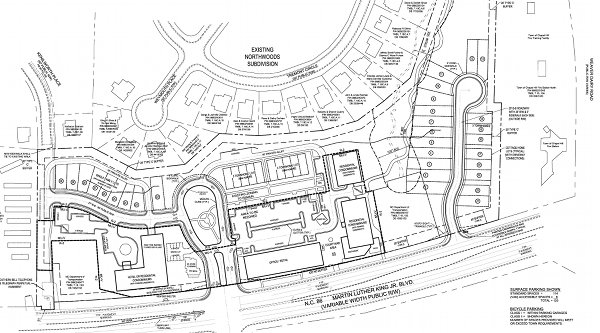This Monday (Apr. 11th,2011), the Council will have the first of two hearings on the Charterwood development. This proposed development supposedly aligns with the goals set forth in both the Town’s aged Comprehensive Plan and the problematic Northern Area Plan.
I’ve read well over a hundred of planning proposals the last decade and have seen a steady trend of “cut-n-pasting” language from other successfully approved proposals to justify a new project – usually generic snippets from the Comprehensive Plan characterizing some community benefit (“well being”) which is hard to objectively pin down.
Certain catch-phrases become de riguer as time goes on: “transit-oriented”, “green”,”sustainable”, etc. Each used to suggest qualities the project might or might not have but each having been successful in pushing other projects through the pipeline.
Because of that applications usually have a strange quirk, some strangled logic, used to justify a quality the project doesn’t innately possess. For instance, the developers of Charterwood are seeking a “mix use village” (MUV) zone and claim their project, which calls for clearing acres of 100-year growth forest to make way for 282 parking spots, is “transit-oriented”.
As Del Snow, a tireless advocate for northern Chapel Hill (who I’ve served with on several advisory boards), points out in today’s Chapel Hill News, the price of this project should be carefully weighed against all the costs it incurs.
As proposed, Charterwood barely meets the criteria laid out in the Northern Area plan. This is not a compact, dense development which seeks to maximize a tracts potential while minimizing its impact on local neighborhoods, current infrastructure and environment.
One example: the “transit-oriented” layout calls for carving an acre of impervious surface parking lot out of the existing tract of 100-year growth trees – a tract which sits at the headwaters of several local creeks. Another: the potential environmental risk posed by shifting the responsibility for maintaining the current on-site catch-basins in this sensitive area from NC-DOT to a private commercial entity.
As Del said in her guest editorial:
Land available for development is dwindling in Chapel Hill. As a result, we will be seeing more and more applications from developers that stretch the limits of our ordinances and ask us to re-assess our priorities.
Council will have to decide if the public good is best served by foregoing the principles laid in our current planning framework or by sticking with those community priorities which balance the public price against private reward.
More on Charterwood’s zoning application, design goals and anticipated footprint.
